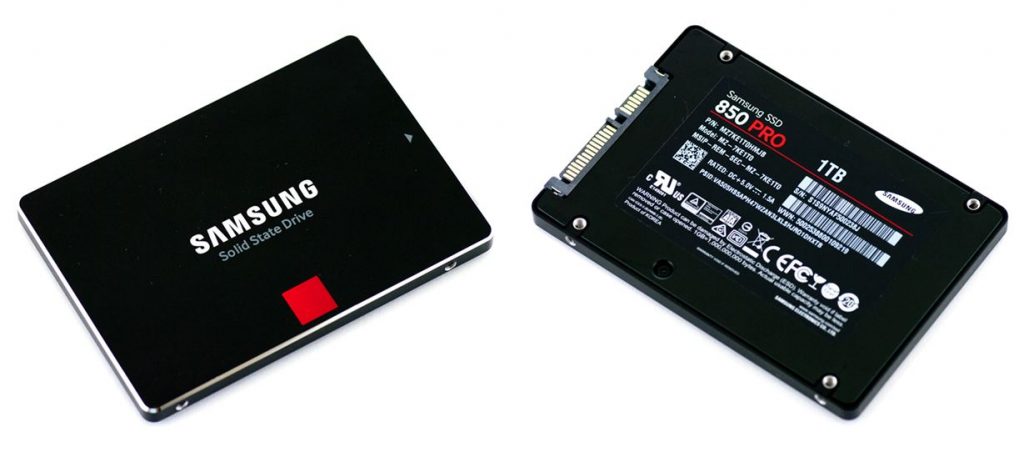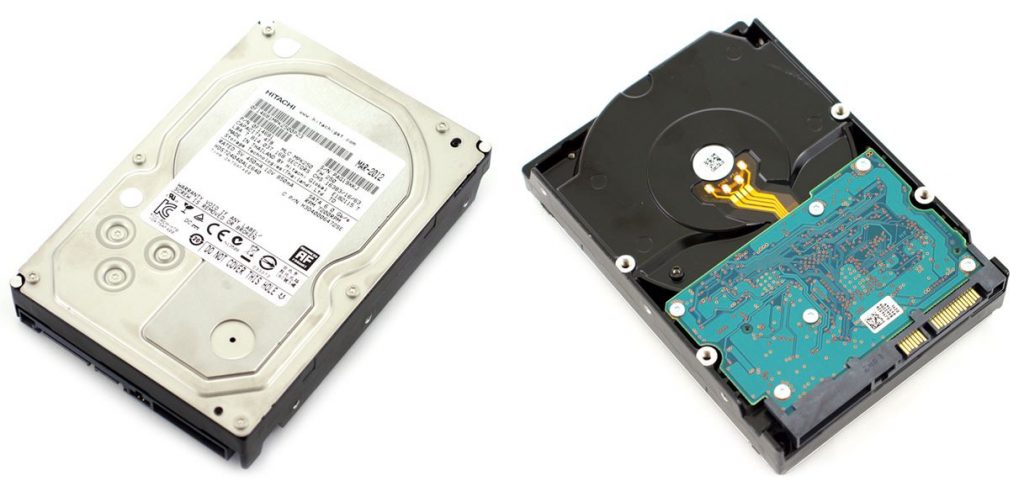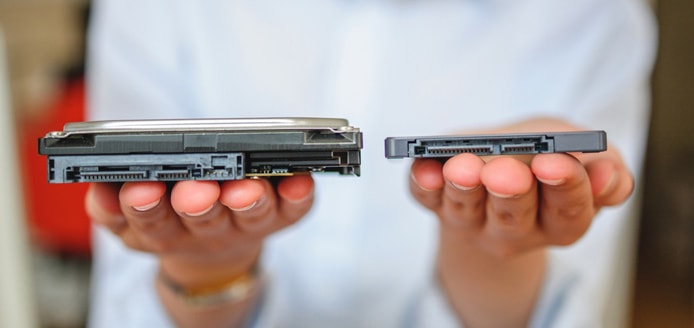SSD vs HDD What’s the Difference?
Until just a few years ago, PC buyers had little choice about what kind of storage to get in a laptop or desktop PC. If you bought an ultraportable anytime in the last few years, you very likely got a solid-state drive (SSD) as the primary boot drive. Larger laptops are increasingly moving to SSD boot drives, too, while budget machines still tend to favor hard disk drives (HDDs). The boot drives in desktop PCs, meanwhile, are a mishmash of SSDs or HDDs; in some cases, a system comes with both, with the SSD as the boot drive and the HDD as a bigger-capacity storage supplement.

If you have to pick just one, though, how do you choose? Let’s get into the differences between SSDs and HDDs, and walk you through the advantages and disadvantages of each to help you decide.
A History of HDDs and SSDs
Hard drive technology is relatively ancient (in terms of computer history, anyway). There are well-known photos of the IBM 650 RAMAC hard drive from 1956 that used 50 24-inch-wide platters to hold a whopping 3.75MB of storage space. This, of course, is the size of an average 128Kbps MP3 file today, in the physical space that could hold two commercial refrigerators. The RAMAC 350 was limited to government and industrial uses, and it was obsolete by 1969. Ain’t progress grand?
The PC hard drive form factor standardized at 5.25 inches in the early 1980s, with the now-familiar 3.5-inch desktop-class and 2.5-inch notebook-class drives coming soon thereafter. The internal cable interface has changed from serial to IDE (now frequently called Parallel ATA, or PATA) to SCSI to Serial ATA (SATA) over the years, but each essentially does the same thing: connect the hard drive to the PC’s motherboard so your data can be shuttled to and fro. Today’s 2.5- and 3.5-inch drives mainly use SATA interfaces (at least on most PCs and Macs), though some high-speed SSDs use the faster PCI Express interface instead. Capacities have grown from multiple megabytes to multiple terabytes, more than a million-fold increase. Current 3.5-inch hard drives have capacities as high as 14TB, with consumer-oriented 2.5-inch drives maxing out at 5TB.

5 Comparisons Measuring SSD and HDD Performance
As the price-per-gigabyte chasm between SSDs and HDDs continues to shrink between 2019 and 2022), more and more people are flocking to SSDs in a variety of uses. In 2014, SSDs powered 21% of all laptops; researchers forecast that number would double by 2017. Conversely, HDD implementation was expected to fall from 79% in 2014 to 59% in 2017. With SSD pricing quickly becoming a non-issue, here are five other ways to compare HDDs and SSDs to see which option might be best for you.

1. SSD vs. HDD: Speed
When comparing the two storage drives, the speed at which data is written and read is the distinguishing factor between HDDs and SSDs. The former uses magnetism to store data on a rotating platter; the faster the platter spins determines how quickly information can be stored. SSDs, however, use flash memory and an embedded processor to store data.
SSDs provide noticeable performance upgrades, both for consumer-grade computers and web hosting servers. Many of our favorite hosts that operate all-SSD infrastructure, including InMotion, A2 Hosting, and DreamHost, say the configuration leads to page loads that are up to 20 times faster.
2. SSD vs. HDD: Reliability
Because there are no moving parts, SSDs tend to be more durable and can better withstand the various bumps or jolts your computer experiences. The read/write process doesn’t degrade, and SSDs will maintain data integrity for more than 200 years.
With platters that spin at 7,200 rotations (or more) per minute, the mechanisms inside HDDs are not only subject to more wear and tear, but they are more susceptible to damage if dropped or bumped.
3. SSD vs. HDD: Lifespan
You know the saying, “speed kills.” While that may be a little exaggerated when it comes to storage devices, it does hold a grain of truth. SSD cells can wear out over time, slowly losing performance before dying. According to many, though, SSD users are far more likely to replace their storage drive because of absoluteness than for suffering from a shorter lifespan.
As for HDDs, the argument is much the same with durability: Moving parts leave more room for things to fail. With only a few nanometers separating the platter and read/write head, any accidental contact can lead to data loss or complete failure.
4. SSD vs. HDD: Power Consumption
This comparison can be illustrated pretty simply. Which takes more energy: running a marathon or tapping buttons on the remote while lying on the couch? HDDs need to spend extra electricity spinning up a stationary platter and moving the read/write head around, while the electricity SSDs use is solely devoted to storing data — no movement, friction, or extraneous noise.
For desktop computers and servers, SSDs equal lower energy bills. On laptops or tablets, users can typically squeeze out a few extra minutes or hours of battery life with SSDs.
5. SSD vs. HDD: Gaming
Resource-intensive computer games provide an excellent test of pushing both storage devices to the limit. However, SSDs make very little difference in game play performance. Frame rate issues won’t be solved by a storage device; those require an upgraded graphics processing unit, or GPU. Some gamer have reported that SSDs can reduce hitching, or the brief pauses when the games can’t pull assets from the hard drive fast enough to keep up with the player.
Overall, SSDs and HDDs are effectively the same when it comes to the action on the battlefield. The SSD benefits to gamers, however, are the same experienced by other PC users: faster boot times and quicker game loading.
The best way to compare items is a table with a side by side comparison of items in which a green box indicates an advantage:
| Attribute | SSD (Solid State Drive) | HDD (Hard Disk Drive) |
| Power Draw / Battery Life | Less power draw, averages 2 – 3 watts, resulting in 30+ minute battery boost | More power draw, averages 6 – 7 watts and therefore uses more battery |
| Cost | Expensive, roughly $0.20 per gigabyte (based on buying a 1TB drive) | Only around $0.03 per gigabyte, very cheap (buying a 4TB model) |
| Capacity | Typically not larger than 1TB for notebook size drives; 4TB max for desktops | Typically around 500GB and 2TB maximum for notebook size drives; 10TB max for desktops |
| Operating System Boot Time | Around 10-13 seconds average bootup time | Around 30-40 seconds average bootup time |
| Noise | There are no moving parts and as such no sound | Audible clicks and spinning can be heard |
| Vibration | No vibration as there are no moving parts | The spinning of the platters can sometimes result in vibration |
| Heat Produced | Lower power draw and no moving parts so little heat is produced | HDD doesn’t produce much heat, but it will have a measurable amount more heat than an SSD due to moving parts and higher power draw |
| Failure Rate | Mean time between failure rate of 2.0 million hours | Mean time between failure rate of 1.5 million hours |
| File Copy / Write Speed | Generally above 200 MB/s and up to 550 MB/s for cutting edge drives | The range can be anywhere from 50 – 120MB / s |
| Encryption | Full Disk Encryption (FDE) Supported on some models | Full Disk Encryption (FDE) Supported on some models |
| File Opening Speed | Up to 30% faster than HDD | Slower than SSD |
| Magnetism Affected? | An SSD is safe from any effects of magnetism | Magnets can erase data |
If we tally up the italic lines , the SSD gets 9 and HDD gets 3. Does that mean the that an SSD is three times better than an HDD? Not at all. As we mentioned earlier, it all depends on individual needs. The comparison here is just to lay out the pros and cons for both options.



